
views
- Place leaves for crafting between paper towels and press them inside a heavy book for 1 week. Or, place them in a flower press.
- Preserve leaves for crafting by covering them in 1 part glycerin and 2 parts water. Keep them in the solution for at least 4 days.
- Dry herbs and tea leaves in the microwave by spreading them between 2 paper towels. Microwave them for 30 seconds at a time until they’re brittle.
Drying Leaves for Craft Projects

Air-dry the leaves if you don't need to keep them flat. Place leaves in a shallow container or tie them in bunches. Expose to direct sunlight for a few days, checking every day or two to see whether they're dry. The sunlight will dry out the leaves, but the edges may curl. This makes them hard to use in some craft projects, but works well for dried flower arrangements. Do not place the leaves in direct sunlight if you wish to retain the full rich greens of the natural leaf. Direct sunlight will cause the colors to fade and become less vibrant. Air flow from a fan or window will dry the leaves faster.

Press the leaves flat and dry with this slow but simple method. Place one large leaf or several small leaves between two sheets of paper towels, making sure none of the leaves overlap. Open a large book such as an encyclopedia and place the sheets between its pages. Shut the book and lay it flat somewhere out of the way. Stack other books or stable heavy objects on top of it. Check once a week to see if the leaves are dry and change the paper towels if they feel damp. If the leaves are wet with rain, blot them dry first with paper towels. Use additional layers of paper towels if the leaves are especially wet or if you're worried about staining the book's pages. When drying multiple leaves in the same book, leave at least 1/8 inch (3 mm) of pages between each sheet of leaves to provide enough weight for each leaf.

Use a flower press instead for faster drying. You can either buy a flower press large enough to place your leaves in, or build your own out of plywood and cardboard. This is more expensive and uses more materials than simply pressing your leaves in a book, but the better air circulation can speed up the drying process by a few days. Spread the leaves out between two paper towels. Put the paper towels in between two sheets of blotter paper or several additional sheets of paper towels. Place the whole stack on the open flower press, then close and tighten. Check every few days to change damp towels and check if the leaves are dry.

Dry large, thick leaves quickly in the microwave. Place a thick leaf between double layers of paper towels on a microwave safe plate. Insert the plate and a small cup of water into the microwave and microwave it for 30 seconds. If the leaf isn't dry yet, microwave it again for 10 seconds at a time, taking the leaf out to check between each microwave session. Warning: the leaf can easily catch on fire in the microwave, which is why you should only use this method on large, thick leaves. The cup of water helps prevent this, since some of the microwave's energy is used to heat the water.

Iron fresh leaves to preserve their color. This method works best on fresh leaves that have not yet changed color or begun to dry, although you should pat them dry with paper towels if the surface is wet. Place one leaf between two sheets of wax paper, and put a towel on top of the wax paper. Heat a clothes iron, then move the iron over the towel while pressing for 2-5 minutes or until that side feels dry. Flip over the stack of wax paper, put the towel over it again, and repeat. Warning: children should have an adult iron the leaves for them, as the iron can get dangerously hot. Make sure the clothes iron is not set to produce steam. Once the leaf is ironed, cut a circle of wax paper out around it and peel off each layer of wax paper. This will leave wax on the leaf to preserve its color.
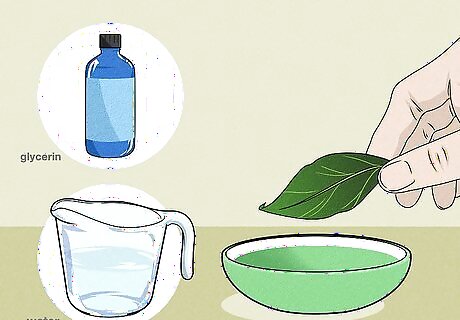
Preserve the texture of leaves with glycerin. This only works on wide, evergreen leaves such as magnolia, lemon, and eucalyptus leaves. This method will turn the leaves brown, but keep them soft and supple indefinitely. Combine one part glycerine with two parts water in a shallow dish, only filling it just enough to cover a layer of leaves. Place the leaves into the liquid, making sure the surface is completely covered. The leaves will be usable in craft projects after about 4 days, or can be soaked for several weeks to preserve them permanently. This method works by replacing some of the water inside each leaf with glycerine, which won't evaporate like water does. If the leaves float to the top, place a paper plate or other object you don't mind getting wet on top of them to keep them weighed down under the liquid. Add more glycerine and water if the liquid drops below the leaves.
Drying Herbs or Tea Leaves

Rinse dirt off fresh-picked herbs. If you have a bundle of fresh herbs that look clean and dust-free, you don't need to wash them. However, if you just picked them from your garden, it's likely they contain some dust and dirt. Rinse them in gentle running water, then shake off the excess water.

Spread out wet herbs until the water evaporates before using any other method. Whether you just rinsed your herbs or they were wet when you received them, you should first dry off the obvious moisture. Spread them out on a paper towel or clean dishcloth until there are no more water beads on the surface of the herbs.

Dry small amounts of herbs or tea leaves quickly in the microwave. If you'd like to use your herbs right away, use this method to dry a small handful at a time. This method is also suitable for tea leaves that have just been used to brew tea. For either material, spread small leaves or pieces of herbs out between two dry paper towels. Microwave for 30 seconds at a time until they are brittle, paying close attention for signs of burning. Moist, fleshy herbs such as mint and basil won't dry easily in the microwave unless they are already partly dried.

Dry thick or sturdy herbs by hanging them indoors. Some herbs don't have much moisture to begin with, and can be dried over the course of a few weeks by tying the stems in bunches and hanging them upside down. Do this indoors in a dark place if possible, because sunlight can harm the color and flavor of the herbs. Herbs in this category tend to have stiff or thick leaves. They include rosemary, parsley, sage, and thyme. If you'd like to dry soft, moist herbs in this way, hang them in small bunches inside a paper bag. Poke holes at the base of the paper bag and place in an area with good air flow so the herbs dry more quickly and mold has less chance to grow.

Dry moist or soft herbs in a low temperature oven. Herbs with soft, juicy leaves need to be dried quickly or they will grow mold. Pluck the leaves off the stem and lay them between paper towels so that no two leaves are touching. You may stack up to five layers of leaves if you need to, alternating between paper towels and herbs. Place these in an oven safe dish and place in an oven at the lowest possible temperature setting. They may take up to 8 hours to dry. Turn your oven dial just enough that only the pilot light or electric oven light comes on. Herbs that dry well in this method include basil, sage, bay leaf, and mint.
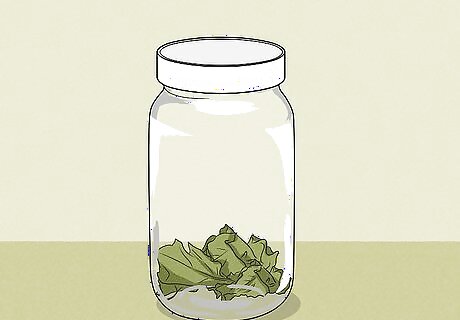
When the herbs are crisp and crumbly, store them in an airtight container. Crumble the herbs between your fingertips before storing or before adding to food. Store dried herbs in an airtight container and place it in a cool, dark, dry place to keep the herbs flavorful as long as possible. Dried herbs have a stronger flavor than fresh herbs. When substituting dried herbs in a recipe that calls for fresh herbs, use 1/3 the amount listed, or 1/2 the amount if the herb is basil. Tea leaves can be dried immediately after used to brew a pot of tea. The microwave method above works best, as you usually have a small amount and a longer drying time could lead to mold. Use dried tea leaves as you would herbs, or use them to cover unpleasant smells around the house.
Making Skeleton Leaves

Choose leaves with thick, visible vein patterns. In this method, you'll be removing most of the leaf and leaving just a network of veins behind. A sturdy leaf that doesn't bend or flop around is a good choice for this project. Freshly fallen autumn leaves from maple or oak trees work well, as do waxy leaves like ivy or magnolia leaves.
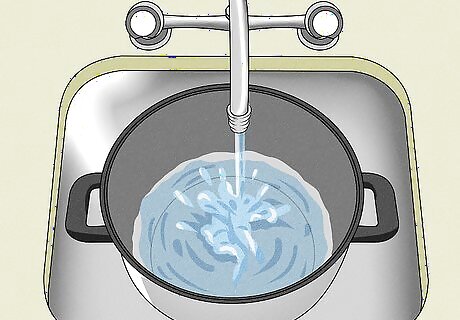
Fill a cooking pot with 1 quart (1 L) water. You can use a smaller pot if you only have a few leaves. If you do, remember to reduce the amount of other ingredients proportionately, or simply use half the amount listed below.
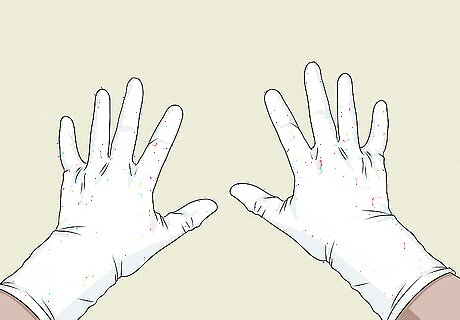
Put on gloves. The mixture you'll be making can damage your skin, so put on latex or rubber gloves before handling the other ingredients. After you're done, remember to wash all utensils used thoroughly in running water while wearing gloves.

Add a little baking soda or washing soda. These chemicals are usually found in grocery or drug stores. Whichever you use, two tablespoons (or 30 grams by weight) should be enough. Either of these chemicals will slowly turn the leaf into pulp while leaving the stem and veins alone.

Add your leaves to the pot. You can fit a couple handful of leaves or more, as long as you can easily stir the pot without spilling.

Heat the pot to a simmer. You may set the heat to low and leave it to eventually simmer, or bring it to a boil, then reduce the heat to low. The mixture should barely or occasionally bubble. If you can measure the temperature, aim for about 175ºF (80ºC).

Leave it to simmer until the leaves are disintegrating, stirring occasionally. Depending on how thick the leaves are, this could take up to a full day, but should probably only take a couple hours. Stir occasionally with a gentle motion, checking to see whether the leaves are soft and falling apart. You'll need to add more water as it boils away. Optionally, you could replace the liquid with a fresh water and baking soda mixture every four hours to speed things along.

Transfer the disintegrating leaves to a pan of cool water. A glass baking dish works well for this step, since it will make it easier to see what you're doing. Carefully remove each leaf with a spatula or other utensil and lay it out onto the baking dish without overlapping the others.

Use a small, stiff brush to remove the remaining pulp. The leaves should be thin, with a mushy layer of pulp stuck to them. Gently and patiently remove this pulp from the leaves, leaving only a network of veins or, depending on leaf type, a thin translucent layer. You may need to rinse off the leaves in a trickle of cold water to remove the pulp one or more times during this process.
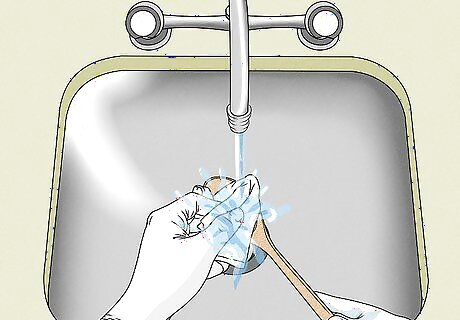
Wash all materials used while wearing gloves. Rinse out the pot, stirring utensil, and other objects that came into contact with the simmering mixture. Wear gloves and use soap and warm water.

Let the leaves dry. You can either let them air dry on paper towels, or pat them dry gently and press them between book pages or a flower press. After a day or two, you will have a unique way to alter the appearance of a dried leaf crafts project. Because these are transparent, they work particularly well on glass surfaces.


















Comments
0 comment